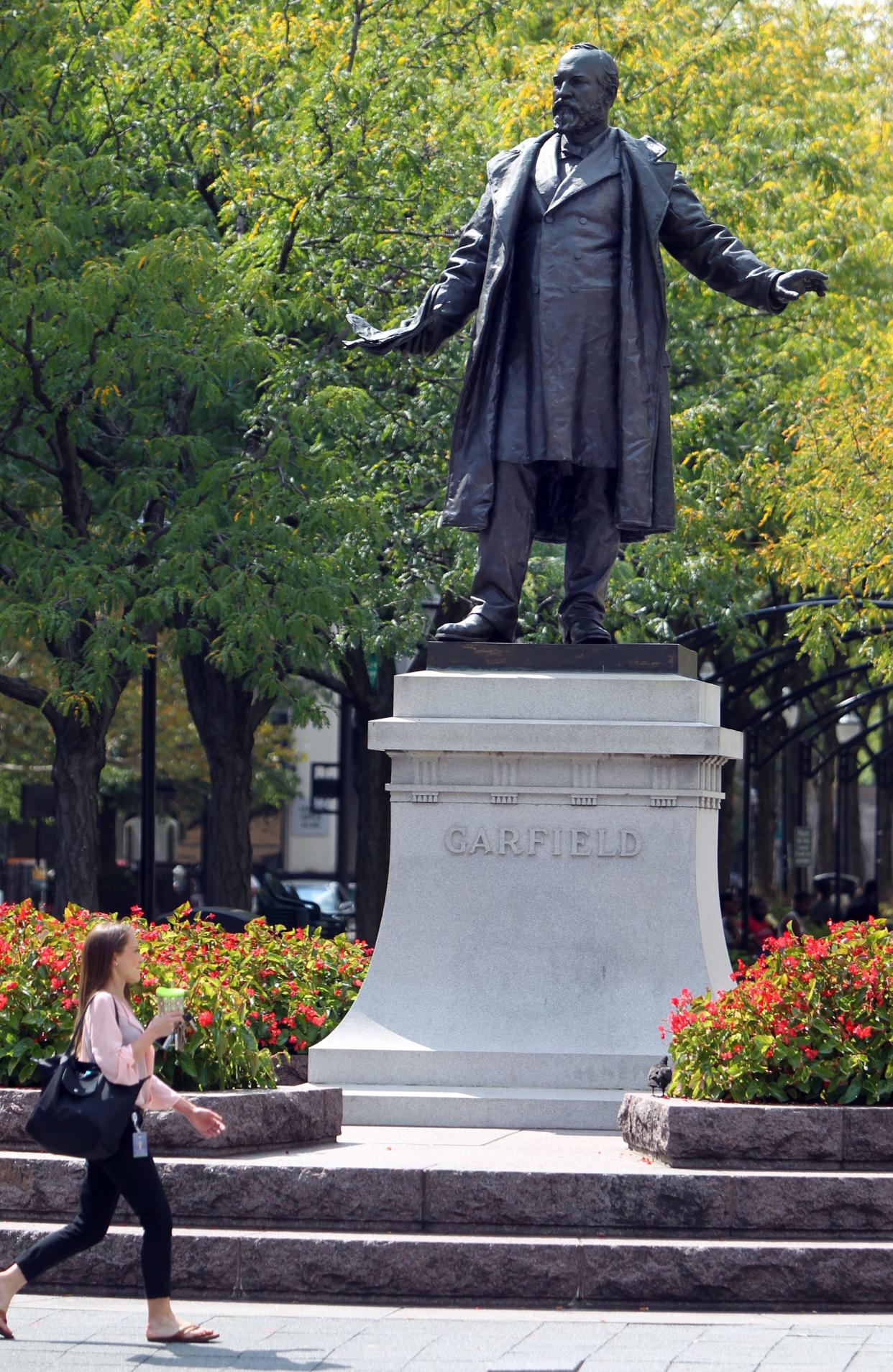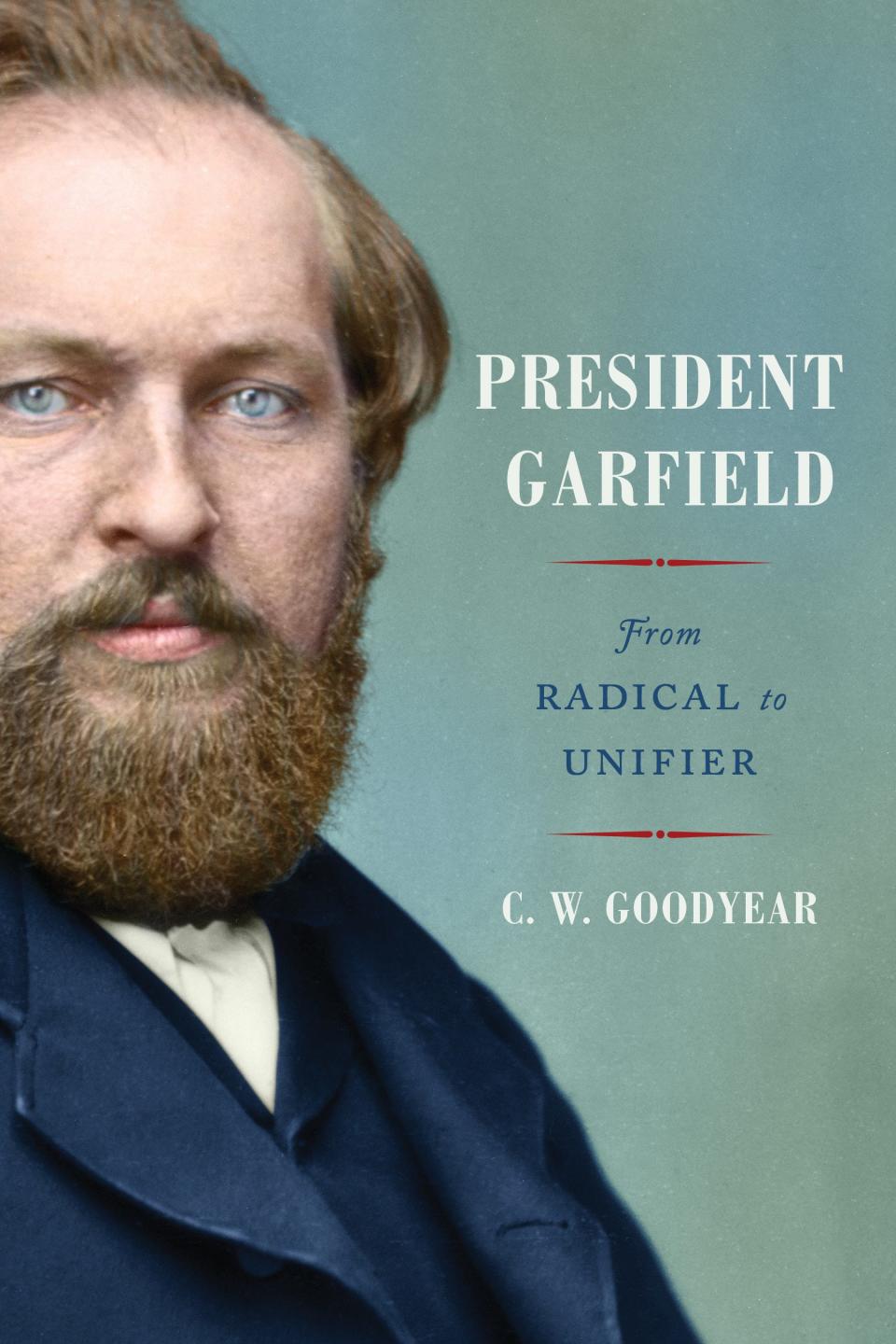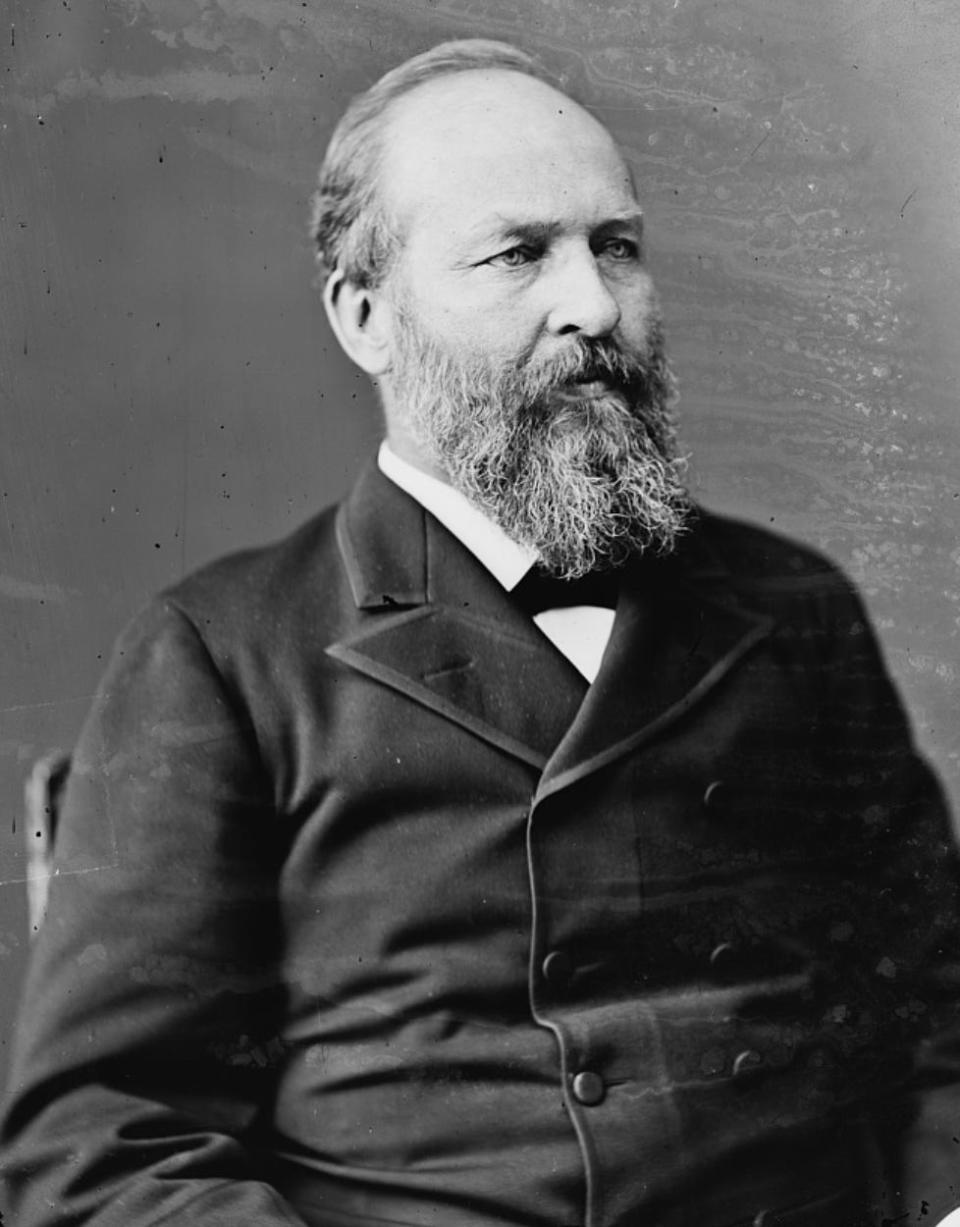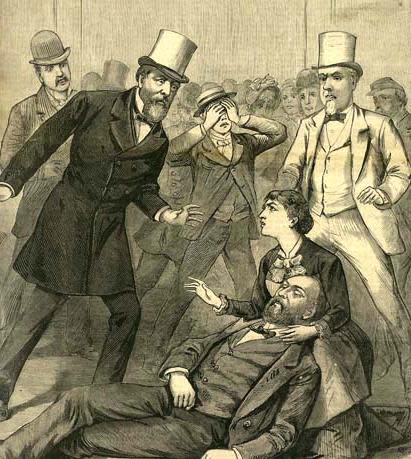Why Ohio's James A. Garfield was more than just an assassinated president

- Oops!Something went wrong.Please try again later.
- Oops!Something went wrong.Please try again later.
President James A. Garfield was not from Cincinnati. He was from Ohio, though – born in the former Orange Township in Cuyahoga County in 1831.
Yet, he has a statue in Piatt Park (formerly Garfield Place), on the corner of Eighth and Vine streets, facing Downtown’s Main Library.
Why is a statue of a nonlocal president with little renown at such a prominent location in Cincinnati? It was erected as a tribute after Garfield was assassinated in 1881.
The bronze figure of the martyred president was sculpted by Cincinnati-born artist Charles Henry Niehaus, commissioned to memorialize the Ohio president during a time of national mourning. Garfield is depicted as an orator, with the pages of his speech in his hand. (Niehaus also crafted the similar statue of Garfield in the National Statuary Hall at the U.S. Capitol in Washington, D.C.)
Cincinnati’s Garfield statue, dedicated in 1887, was originally placed on a pedestal in the middle of the road at the intersection of Eighth and Race streets, but because it obstructed traffic, it was moved inside the park in 1915. Then, as part of the Piatt Park remodel in 1988, the Garfield statue was relocated to its current spot, formerly occupied by the equestrian statue of William Henry Harrison, which was moved to the opposite end of the park.
Historian C.W. Goodyear, author of the new biography “President Garfield: From Radical to Unifier,” makes a case that we should know more about the 20th president than just his statue.
Garfield was often a footnote in history, known as the president who died less than a year into his term, Goodyear told The Enquirer. “The deeper I got into the man himself, the less fair that seemed to be as his record,” he said.
Garfield wrangled with the politics after the Civil War

“I wanted to find a period of American history where the conditions of American society at that time – social, economic, political – were maybe somewhat analogous or comparable to today’s, but somebody on a national level was resisting the device or the spirit of the times,” Goodyear said.
“I found the same person kind of floating in the background of pretty much every major event between Reconstruction and the early Gilded Age,” he said. “It was also somebody who everybody was saying vaguely nice things about, sometimes in a passive aggressive way. Nevertheless, positive regardless of their own personal politics. And that person was James Garfield.”
Garfield represented Ohio’s former 19th District in the U.S. House of Representatives from 1863-1880. His tenure in the House came came during the entire tumultuous Reconstruction Era following the Civil War, from the passage of the 13th Amendment that abolished slavery to the compromise that helped settle the 1876 election in favor of Rutherford B. Hayes, who lost the popular vote but narrowly won the electoral vote.
Then, Garfield was the compromise candidate in 1880, winning the Republican nomination on the 36th ballot. He won the presidency, becoming the only sitting House member to be elected to the White House.
Started so low, accomplished so much
President Hayes wrote of Garfield: “The truth is no man ever started so low who accomplished so much in all our history. Not Franklin or Lincoln even.”
He certainly had a hardscrabble upbringing. Garfield was the last U.S. president born in a log cabin. His father died when he was 2, and the kids had to pitch in to help their widowed mother. Garfield worked as a mule driver for a canal boat, a school teacher and a preacher. He paid his way to the Western Reserve Eclectic Institute (which became Hiram College) by working as their janitor.
He finally graduated from Williams College in Massachusetts, where he fomented his abolition views that sent him into politics.
When the Civil War broke out, Garfield commanded the 42nd Ohio Infantry Regiment and rose to the rank of major general. While the war still raged, he was elected to the House. President Abraham Lincoln told him they had too many generals than they knew what to do with but a shortage of congressmen. So, Garfield resigned from the Army and joined Congress.
There, he allied himself with the Radical Republicans, who advocated for abolition and Black suffrage. He supported the impeachment of President Andrew Johnson, who had taken over the presidency after the assassination of Lincoln. When Johnson was not removed from office, Garfield blamed his own former mentor, Salmon P. Chase, who presided over the trial as chief justice on the Supreme Court.
Kept an open mind to other viewpoints

Despite serving in one of the most contentious political eras in American history, Garfield remained civil with political friends and enemies alike. He was someone “who believed in bridging divides,” Goodyear said.
“He was really never one to entirely cloister his mind or shut off his mind from alternative viewpoints,” he said.
This frustrated some of his Republican critics, including Ulysses S. Grant and Frederick Douglass, who claimed Garfield had no moral backbone.
“It was because they were perceiving his kindness and open-mindedness as profound weakness,” Goodyear said. “But he would turn that back on them. Garfield’s position was that it was extremism and close-mindedness that was easier than being an open-minded moderate.”
That stance was difficult for Garfield, who wrote, “To be an extreme man is doubtless comfortable. It is painful to see so many sides to a subject.”
Garfield’s life and death provide lessons on politics
Not everyone respected their opponents.
One of the major conflicts of his presidency was the Republican infighting between the Stalwarts, who supported political machines and the spoils system of giving positions to supporters, and the Half-Breeds, including Garfield, who favored civil service reform and the merit system.
Charles Guiteau, who thought he deserved a political position for helping Garfield get elected, decided to kill the president so that Vice President Chester A. Arthur, a Stalwart, would be in charge.

On July 2, 1881, Guiteau shot Garfield twice at a train station in Washington, D.C., and declared, “I am a Stalwart of the Stalwarts. Arthur is president now!”
Garfield lingered for months as doctors, with the limited medical knowledge of the time, made things worse as they probed the wounds with unsterilized fingers and used magnets to look for the bullets. He died Sept. 19, 1881.
His death did bring about political change. President Arthur defied expectations by signing the Pendleton Civil Service Reform Act (which was drafted in 1882 by Sen. George Hunt Pendleton at his Cincinnati home, which still stands on Prospect Hill).
But it is Garfield’s life that can provide lessons on politics today, which has similarities with that period of national conflict, contested elections and refusal to compromise. Our times are not unprecedented.
“We have somewhat been through this before,” Goodyear said, “and I think Garfield’s life is a demonstration of how we were able to get through it, for better or worse.”
C.W. Goodyear will be discussing and signing “President Garfield” on Tuesday, July 11, 7 p.m., at Joseph-Beth Booksellers, 2692 Madison Road, Norwood.
This article originally appeared on Cincinnati Enquirer: Why is there a statue of President James Garfield in Cincinnati?

